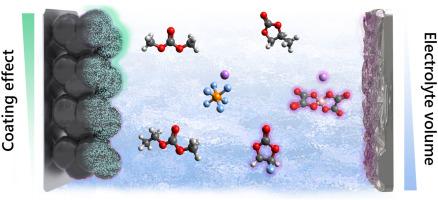阴极保护层对含FEC和LiBOB电解质中NMC/Li电池性能影响的评估
IF 7.9
2区 工程技术
Q1 CHEMISTRY, PHYSICAL
引用次数: 0
摘要
实现高压锂离子电池(LIBs)的稳定循环需要电解质组成和电极界面的协同设计。本文研究了电解质成分和人工阴极涂层对NMC622阴极的综合影响。首先,我们对商业电解质进行了深入的研究,以形成富含liff / bob的界面。该电解质以碳酸二甲酯/碳酸甲酯乙酯/碳酸氟乙烯/碳酸丙烯(DMC/EMC/FEC/PC, 3:3:3:1, v/v)为基料,含有0.95 M的六氟磷酸锂(LiPF6)和0.05M的双(草酸)硼酸锂(LiBOB)。该系统与含有1 M LiPF6的标准二进制EC:EMC电解质进行了比较。涂层通过电泳沉积(EPD)应用。该研究评估了阴极保护涂层在四元电解质中是否进一步提高了长期可循环性,而不是标准电解质所提供的增强。分子动力学(MD)模拟揭示了配方电解质中不同的锂离子溶剂化结构,证明了富LiF/ bob界面相的形成。电化学测试表明,电解质成分在决定循环性能和界面电阻方面起主导作用,而人工涂层提供了额外的稳定性。优化后的组合在2.8-4.5V电压截止下,经过300次循环后,容量保持率超过80%。这些结果强调了整合溶剂化化学和表面工程来稳定先进lib中电极-电解质界面的重要性。本文章由计算机程序翻译,如有差异,请以英文原文为准。

Assessment of the impact of cathode protection layers on the performance of NMC/Li batteries in electrolytes containing FEC and LiBOB
Achieving stable cycling of high-voltage lithium-ion batteries (LIBs) requires co-design of electrolyte composition and electrode interphases. Here we investigate the combined effects of electrolyte composition and artificial cathode coatings on NMC622 cathodes. Initially, we present an in-depth examination of the commercial electrolyte designed to form LiF/BOB-rich interphases. The electrolyte is based on a quaternary carbonate solvent - dimethyl carbonate/ethyl methyl carbonate/fluoroethylene carbonate/propylene carbonate (DMC/EMC/FEC/PC, 3:3:3:1, v/v), and contains 0.95 M lithium hexafluorophosphate (LiPF6) and 0.05M lithium bis(oxalato)borate (LiBOB). This system is compared against a standard binary EC:EMC electrolyte containing 1 M LiPF6. The coatings are applied via electrophoretic deposition (EPD). The study evaluates whether cathode protective coatings in the quaternary electrolyte further improve long-term cycleability, beyond the enhancement provided by the standard electrolyte. Molecular dynamics (MD) simulations reveal distinct Li-ion solvation structures in the formulated electrolytes, demonstrating the formation of LiF/BOB-rich interphases. Electrochemical testing shows that electrolyte composition plays a dominant role in determining cycling performance and interfacial resistance, while artificial coatings provide additional stability. The optimized combination achieves over 80 % capacity retention after 300 cycles at 2.8–4.5V voltage cut-offs. These results highlight the importance of integrating solvation chemistry and surface engineering to stabilize electrode-electrolyte interfaces in advanced LIBs.
求助全文
通过发布文献求助,成功后即可免费获取论文全文。
去求助
来源期刊

Journal of Power Sources
工程技术-电化学
CiteScore
16.40
自引率
6.50%
发文量
1249
审稿时长
36 days
期刊介绍:
The Journal of Power Sources is a publication catering to researchers and technologists interested in various aspects of the science, technology, and applications of electrochemical power sources. It covers original research and reviews on primary and secondary batteries, fuel cells, supercapacitors, and photo-electrochemical cells.
Topics considered include the research, development and applications of nanomaterials and novel componentry for these devices. Examples of applications of these electrochemical power sources include:
• Portable electronics
• Electric and Hybrid Electric Vehicles
• Uninterruptible Power Supply (UPS) systems
• Storage of renewable energy
• Satellites and deep space probes
• Boats and ships, drones and aircrafts
• Wearable energy storage systems
 求助内容:
求助内容: 应助结果提醒方式:
应助结果提醒方式:


